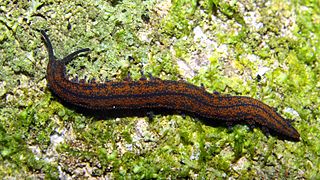
Peripatus is a genus of velvet worms in the Peripatidae family. The name "peripatus" is also used to refer to the Onychophora as a whole, although this group comprises many other genera besides Peripatus. The genus Peripatus is found in Central America, the Caribbean and northern South America.
Mesoperipatus is a monospecific genus of velvet worm in the Peripatidae family, containing a single species Mesoperipatus tholloni. It is found in Gabon, making it the only known species of velvet worm in the tropics of Africa, and the only known species of peripatid velvet worm in Africa. Females of this species have 24 to 27 pairs of legs; males have 23 or 24.

Peripatoides is a genus of velvet worms in the family Peripatopsidae, whose species are found in New Zealand. Like all velvet worms, these animals are nocturnal hunters that spit glue to trap their prey. Species of Peripatoides have 14, 15 or 16 pairs of legs. Female Peripatoides produce eggs that are fertilized internally and babies develop inside their mother until large enough to be born, in batches of 4-6, as colourless miniatures of the parents. These live-bearing Peripatoides have dermal-haemocoelic sperm transfer - which means sperm dissolve holes in the skin of the female to enter the body (haemolymph) anywhere on the body wall of the female.

Peripatopsis is a genus of South African velvet worms in the Peripatopsidae family. Velvet worms in this family feature a last pair of legs that is rudimentary or reduced in size.

Peripatidae is a family of velvet worms. The oldest putative representatives of the family herald from Burmese amber dated to the mid-Cretaceous, around 100 Ma, with representatives from Dominican and Baltic amber attesting to a broader distribution in the Palaeogene / Neogene; molecular variability suggests that the family's crown group may have arisen in the early Mesozoic.
Planipapillus is a genus of velvet worms in the family Peripatopsidae, whose species are found in Victoria and New South Wales, Australia. They are commonly known as lawn-headed velvet worms and feature patches of reduced papillae prominence on the head, posterior to the eyes. All species in this genus are oviparous and have 15 pairs of oncopods (legs).
Lathropatus is a monospecific genus of ovoviviparous velvet worm containing the single species Lathropatus nemorum. The type locality of this species is Cobboboonee National Park, Victoria, Australia. This species has 15 pairs of oncopods (legs).

Occiperipatoides is a monospecific genus of velvet worm containing the single species Occiperipatoides gilesii. This genus is ovoviviparous and found in Western Australia. The genus is part of the ancient phylum Onychophora that contains soft-bodied, many-legged relatives of arthropods known commonly as velvet worms.
Ooperipatus is a genus of Australian velvet worms in the Peripatopsidae family. All species in this genus are oviparous and have 15 pairs of oncopods (legs).
Metaperipatus is a genus of velvet worms in the family Peripatopsidae that includes the species Metaperipatus inae. Males of this species have 20 pairs of legs; females have 22 pairs. This species is a dark grayish blue in color, with large orange/red spots. The type locality is in central Chile.
Epiperipatus imthurni is a species of velvet worm in the family Peripatidae. The type locality is in Guyana. No males have been recorded from this species. Females have 28 to 32 pairs of legs, usually 30 or 31. Females from Trinidad were shown to reproduce via parthenogenesis; the only velvet worm known to do so.
Eoperipatus horsti is a species of velvet worm in the Peripatidae family. Females of this species have 24 or 25 pairs of legs; males have 23 or 24. The type locality is in West Malaysia.
Epiperipatus barbouri is a species of velvet worm in the Peripatidae family. Females of this species have 30 to 34 pairs of legs. The type locality is in Grenada.
Epiperipatus trinidadensis is a species of velvet worm in the Peripatidae family. Males of this species have 27 to 30 pairs of legs; females have 29 to 32. The type locality is in Trinidad.
Epiperipatus paurognostus is a species of velvet worm in the Peripatidae family. Males of this species have 26 or 27 pairs of legs; females have 27 to 29. The type locality is in Minas Gerais, Brazil.
Oroperipatus peruvianus is a species of velvet worm in the Peripatidae family. Males of this species have 34 pairs of legs; females have 36 or 37. The type locality is in Peru.
Peripatus dominicae is a species of velvet worm in the Peripatidae family. Males of this species have 25 pairs of legs; females can have 28 to 31 pairs of legs, but usually have 29. The type locality is in Dominica.

Peripatus juliformis is a species of velvet worm in the Peripatidae family. Females of this species have 33 or 34 pairs of legs; males have 29 or 30. The type locality is on Saint Vincent Island.
Paraperipatus lorentzi is a species of velvet worm in the Peripatopsidae family. The male of this species has 21 pairs of legs; females have 22 or 23 pairs of legs. The type locality is in Western New Guinea, Indonesia.
Macroperipatus ohausi is a species of velvet worm in the Peripatidae family. Females of this species have 27 or 28 pairs of legs. The type locality is Rio de Janeiro, Brazil.





